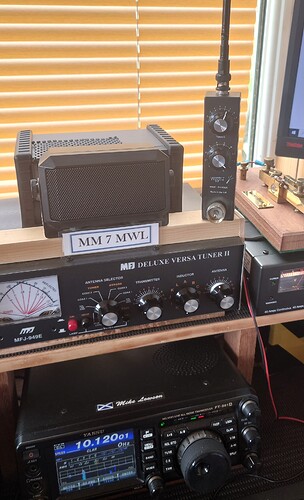Has anyone had any success with these antennas? I know that there is no miracle here but seeing how the AX1 does seem to perform ok despite the size, I wonder if these would work in a similar way?
The only miracle or wonder involved is that people will pay out serious dosh for this rubbish.
If you really want something wonder-ful, that in some situations appears to be a miracle (but isn’t), then build a quarterwave-with-elevated-groundplane antenna yourself and try it from a summit with a QRP rig like an 817.
Very easy to make - no technical skill required - and very cheap too.
Yes I get it. Totally. But sometimes a compromised yet somewhat workable portable solution, incredibly compact and super quick to put up with no required supports would be nice!
Like I say, the AX1 is a similar size and it does make contacts! However, needs an ATU. This type looks like the ATU is also built in.
73!
The difference is the AX1 says Elecraft on it.
“compromised” can take a QRP rig out of the game in flat conditions.
“no required supports” relies on their being little or no wind - a rarity on UK summits!
“super quick”: <5 minutes to deploy my GP antennas. No ATU involved nor necessary.
It’s the antenna solution that has everything*.
- quick to deploy
- very lightweight / compact
- very cheap
- the satisfaction of making it yourself
- proven to work the DX
*What it doesn’t have is multiband capability. You build a resonant GP antenna for each band you want to operate on. I’ve made one for each of the 30m, 20m, 17m, 15m, 12m, 10m and 6m bands. I usually just choose one and operate on that band, but I occasionally pack two of them and swap antennas over mid-activation.
OK. I give up. I confess. I bought a WonderWand for my FT818 a few years ago when I knew even less than I do now. Fine as tunable RX antenna but my experience suggests it’s not much use on TX, albeit many say otherwise. Not much beats a decent wire for cost, efficiency, weight and ease of deployment, esp working QRP on a summit. A compromise will always be a compromise where something, or someone, has to lose out. 73 Mike
(older, wiser and a good few hard-earned pounds poorer ![]() )
)
Had one of these Miracle Whip antennas as a receiving antenna and gave it a try for an activation. Got reports between 319-579, while with a regular vertical I would have received 559-599. TRX = 3 x QCX.
Somewhere I read the antenna had a gain of -21db on 20m…
However, did some improvements by adding a contact for 4 radials. Otherwise the reports would have been worse.
But anyway - worked stations in Europe from 30m-17m… 40m did not work.
A pity that the SOTA database does not save reports…
73
Ingo
Added: It was only an experiment … ![]()
They’re not needed for claiming awards so they are not supported.
If you put them in the comments they are saved.
Oh behalf of chasers everywhere, please use a better antenna.
There are two use cases for these extremely compromised antennas: no space on the summit or no time to put up a proper antenna. If you use these as your ‘everyday’ antenna, you are excluding a lot of people from chasing you. SOTA without chasers doesn’t work, so remember to be nice to your chasers and give them the best chance of hearing you.
73
You’re a marketing mans dream! Is it better or worse than your socktenna or what ever it is called? ![]()
And a bank manager’s nightmare ![]() . Schoolboy error, 50 years after I left school! The jury’s still out on the Bantenna meantime though, but the quest to find a suitable multiband HF antenna that fits in a small campsite pitch, without using a vertical on a magmount, continues……
. Schoolboy error, 50 years after I left school! The jury’s still out on the Bantenna meantime though, but the quest to find a suitable multiband HF antenna that fits in a small campsite pitch, without using a vertical on a magmount, continues……![]() 73 Mike
73 Mike
Hi Olly,
I bought one of the cheaper clones of the Wonder/Miracle whatever unit about 10 years ago and the variable inductor part actually isn’t bad! The “tuner” plus whip does not perform that well but I used its tuner with a set of EFHW wires for a while, but it needed a counterpoise wire as well. Probably not what you are looking for.
Diamond sells the RHM-8B which is somewhat better - it’s designed to fit the BNC socket in the top of an FT817/818 but given the weight and length of its whip, I always worried that it could break the socket on the Yaesu (it never did though).
At the end of the day, a wire antenna and a throw bag to get a cord into a tree to haul it up will always outperform the mini-whip antennas.
At the moment my favourite for limited space summits is the Komunica HF-PRO2Plus-T (don’t marketers love long names!) on top of a self-modified photo tripod with 8 x 3m radials. set up in less than 5 minutes and has worked with contacts all around Europe and a couple of times down into VK using 20w. If you don’t want to modify an old tripod, Komunica (which is a Spanish company by the way) also sells a tripod with a radials kit. This is not a “mini whip” in any way by the way - it’s large once the 2.7m telescopic section is extended out.
73 Ed.
PS I thought Miracle Whip was a salad dressing or something…

“compromised” Conjures up the wonderful / funny article of long ago by Tom Schiller, N6BT, entitled “Everything Works” His cover picture was a 100-Watt light bulb, in a porcelain poney cleat socket, mounted on a fence post, about 4 feet high. Made many contacts with 100 Watts.
Now, go look up poney cleat socket!
Ken
Ahhhh, yes!
If you use Miracle Whip in American-style potato salad, instead of ordinary mayonnaise, you will be in for a treat! Many people who were around in the 1940’s and '50’s remember it well, and still make it that way.
Ken
Was he the same guy who did an article in QST about soaking some natural twine in a very strong brine solution and using “wet string” as an antenna? It worked quite well until the string dried out ![]()
Wet String is the perfect SOTA antenna for the PacNW… it will never dry out (except maybe for a week in August) ![]()
Andy,
Don’t remember that one; however, do remember recently describing to someone what propagation was like in the late 1950’s: “All you needed was a piece of wet spaghetti and a 6L6 (valve) to work the world!”
All Best, Ken
It was the 1957 IGY solar maximum which was really big. There was much less interference (no computers or switched mode PSUs) and enough hams worldwide and a fair amount of ex WWII surplus valves(tubes) that all helped make things exceptional. Maybe this maximum will be a good one too?
One can hope! Maybe by fall, things will get better; at present. it’s changing by the day.
Hi,
I have a Chinese whip that is 17 ft extended. Comes with a loading coil for 40 m. The whip can be adjusted for frequencies up to 50 MHz. It has a ground stake and 4 computer ribbon radials. It works reasonably well and is quick to deploy.
I also have also tried a small AX2 type of whip with tapped coil for most bands. I put it on a camera tripod and threw out three radials. I was most surprised to work a ZL on 20 m circa 2,500 km. I got three difficult contacts on 40 m, 450 to 650 km . About par for the course I’d say. The summit was a total ant hill and a quick activation was needed.
None of the South Africans I’ve worked in the last year came anywhere near the 1958 10 m signals from that part of the World. A pair of 807s modulated by another pair in plate and screen mode sounded wonderful. I could hear the chickens and dogs in the background as clearly as if they were outside my own window. We know an 807 is the RF version of the 6L6 and in some places the 807 s used had 813 printed on them. Just saying.
A recent study showed a big increase in background noise from SMPS, LED lights etc. In the North Sea!. No need for a study to tell me that my S meter readings of high noise here in Melbourne town are evidence of a HF disaster.
73
Ron
VK3AFW
